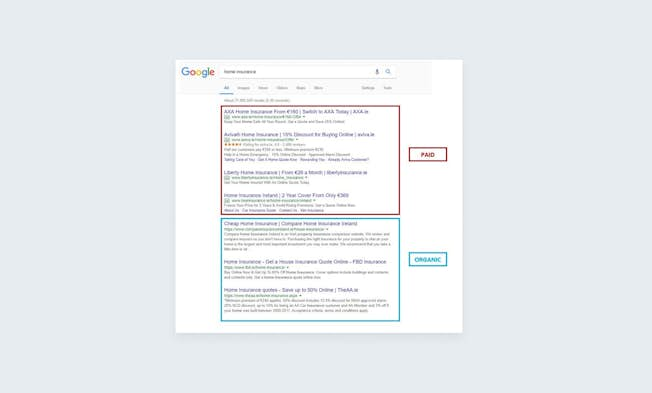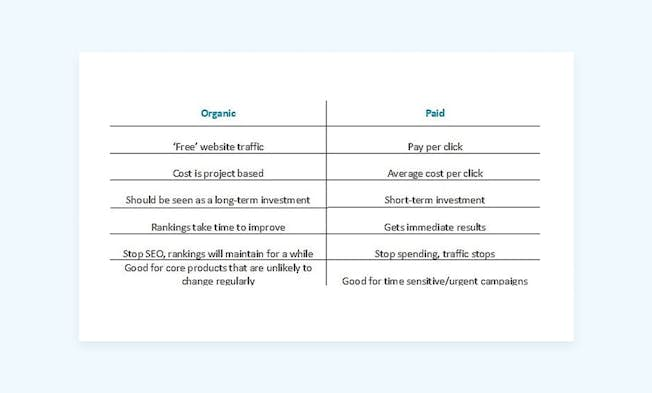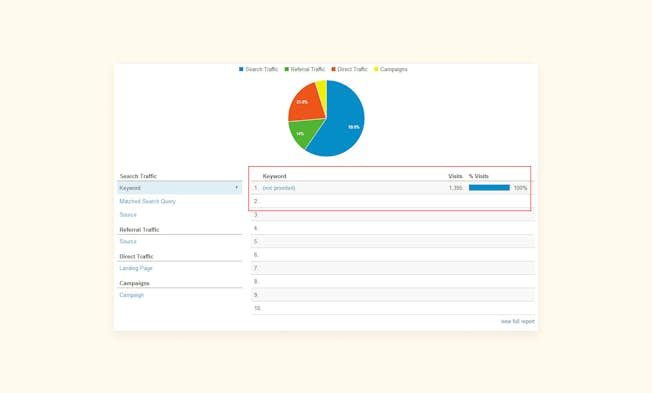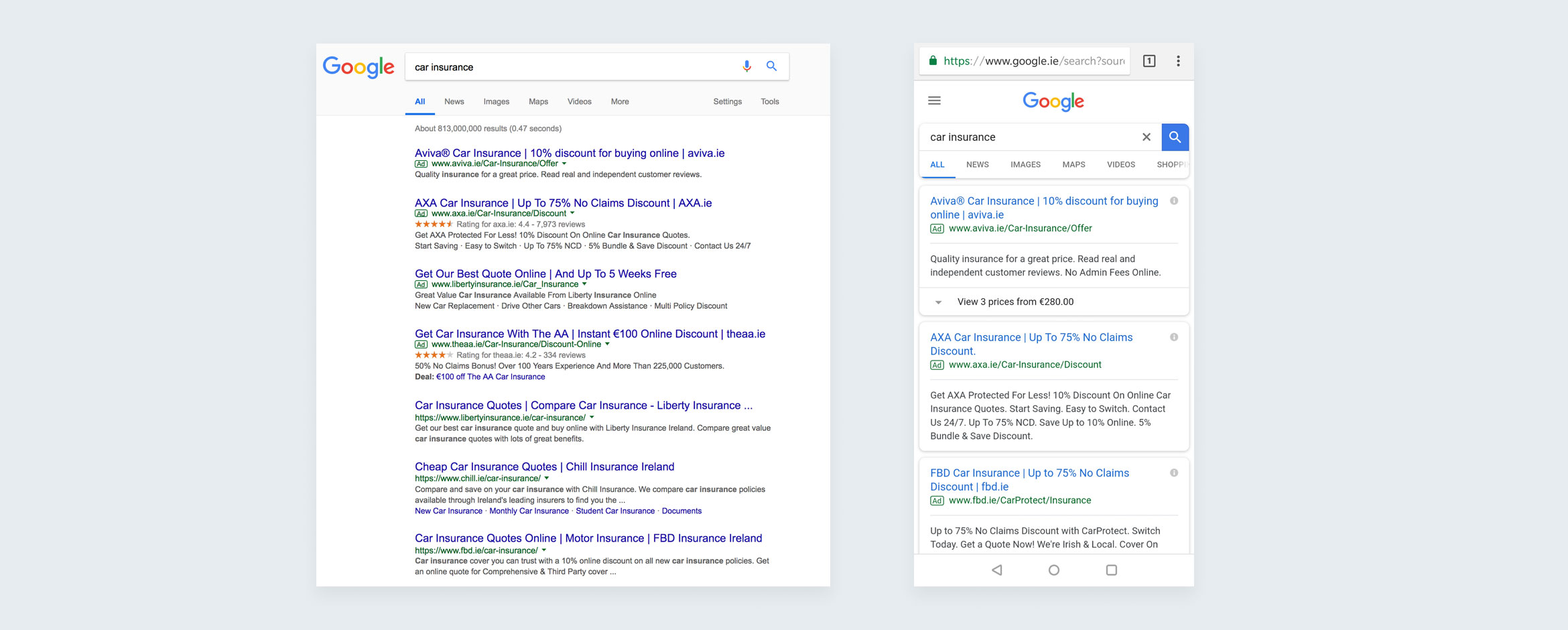Nov 13, 2018
Paid vs Organic Search – Striking the Right Balance
Often when you read articles comparing paid and organic search, they are pitched as two opposing areas of digital marketing. A choice needs to be made it seems as to which of the two channels to focus your budget and resources on. For a start, it’s time to stop thinking about paid vs. organic search as a battle when a far more productive view is to see the two channels as complementary and to work towards maximizing your brands presence across both channels.
It is worth a quick recap of what exactly we are referring to when we say paid and organic search. As you can see from the below screengrab, Google has evolved to the extent that it is very difficult to distinguish between what is a paid ad and what is organic. Whereas paid ads used to sit in a yellow shaded ‘sponsored’ box, the only distinguishable difference now is the small green ad symbol to the left of the paid results.

Paid Search Results
The paid search results are displayed at the top of the page, typically from position 1–4. These advertisements provide a paid alternative to help users find what they are looking for through keyword targeting and are managed through the Google AdWords platform.
Organic Search Results
The organic search results are the core list of results that show underneath the top four paid results. Organic search results rank from 1–10 on each page, and with Google Places listings at times taking more real estate on the SERP, there can be as few as six organic search results. Over time, it is becoming more and more of a challenge to ensure a website is maximizing its organic or ‘free’ traffic.
Difference Between Paid and Organic
Before going into some strategies through which you can manage both channels to complement each other, it is worth outlining the key differences between them:

So now that we know the main differences between paid and organic, here are four scenarios where you can generate synergies between paid search and search engine optimization (SEO).
1. Use Paid Search to Inform Organic Keyword Research
One key benefit of running pay per click (PPC) and SEO in tandem is the ability to use the rich keyword data within AdWords to inform your SEO efforts. Unfortunately for anyone working solely in SEO, it can be difficult to get access to organic keyword information as the vast majority of organic keywords will be bundled into (not provided) in Google Analytics.

A good way to overcome this issue is to use your paid search data to inform your SEO strategy. When running paid search, you will be able to report on keyword level performance to a very granular level and using the two columns ‘impressions’ and ‘impression share’ in particular can help you calculate the total monthly search volume for a given term. This information can arm your SEO strategy with the knowledge of which keywords are the most important when optimizing your site and content.
2. Rely on Organic for Brand Traffic and Paid for Generic
A general rule of thumb is that consumers use generic terms during research phase and brand terms when they are more likely to make a purchase.
A practical example of this would be someone looking to buy soccer boots. They may initially search ‘best soccer boots for soft ground’. This user is looking to research several different brands, read reviews, and then finally decide on the brand of boots they would like. Upon making their decision, they would likely perform a brand search such as ‘adidas world cup boots’ and buy from whichever site offers them the best deal.
In the above example, Adidas will naturally rank very strongly (almost always top of page) organically because it is their own brand term. Because they are at the top of the page already they may decide not to engage in paid search activity for this term.
However, when the user searched for ‘best football boots for soft ground’ there would have been a myriad of brands and websites to consider and it would have been a lot more difficult for Adidas to rank in position one for this term. As a result, they may want to run paid activity for these types of longer tail, more generic search terms. So a rule of thumb that an advertiser may follow is to push more budget to generic paid search to try capture consumers in the research phase and to rely on their organic brand listing to capture the sale.
3. Ramp Up Paid Search Where Organic Presence May Be Poor
Every brand will want to rank in position one organically for every keyword that is relevant to their business. This, however, is simply not possible. Similarly, every brand would love to own position one for every keyword they bid on in the paid listings, but to do this would prove incredibly expensive.
So, a smart and collaborative search strategy is to try to dovetail paid and organic listings. This can be achieved by benchmarking organic rankings across a wide number of keywords relevant to the business. For terms (such as brand terms) where the site has a strong organic ranking, they could potentially pull back on paid and allow their organic listing to capture as much of the traffic from that keyword as possible.
Conversely, if the brand’s rankings for certain, longer tail keywords was poor or not even on page one of Google, then they can make sure they have some visibility at the top of the search results page by engaging in some paid. It is a clear example of where a strategy combining the two search channels can result in delivering overall budgeting efficiencies.
4. Paid Search for Mobile, Organic for Desktop
Below are two screengrabs – for mobile and desktop – that show the top of the search results page for the phrase ‘car insurance’. Desktop obviously displays more results, considering it has a much larger screen – four paid results and one organic. A mobile device’s screen size, on the other hand, only allows for the top three paid ads to be visible.

There is also no doubt that mobile users are more impatient and are seeking immediate answers rather than wanting to scroll and jump between different pages and tabs.
The outcome of this is that users will be more likely to click on paid ads on mobile whereas desktop users may be more inclined to scroll down and research the organic listings. As a marketer, a clever tactic would be to weight slightly more budget towards mobile activity; this would also be consistent with the trend of mobile traffic overtaking desktop. A final challenge of this strategy would be to ensure that your website’s mobile experience and check out forms are extremely user friendly.
In summary, it is clear there are many differences between the marketing channels of paid and organic search. It would be naïve to proceed with an approach of choosing to focus on one while sacrificing the other. Any good marketing strategy should be viewed from a broader, more holistic basis.
The ideal goal will always be to get prospective customers to your site, offer them an excellent user experience, and convert them to a sale. In terms of which channel delivers that sale, it’s not about organic vs. paid search – it’s about understanding how your customers research online, strategizing your paid and organic search channels, and ultimately delivering solutions that will best help them to find your content.
Upgrade to Power Membership to continue
your access to thousands of articles, toolkits, podcasts, lessons and much much more.
Become a Power Member- Login
- View Courses
- - - -
- Courses
- Resources
- - - -
- My Account
- Change Password
- Logout




